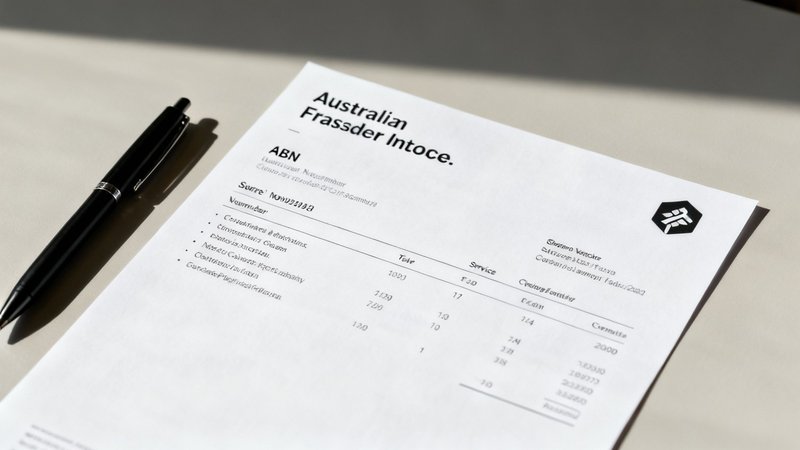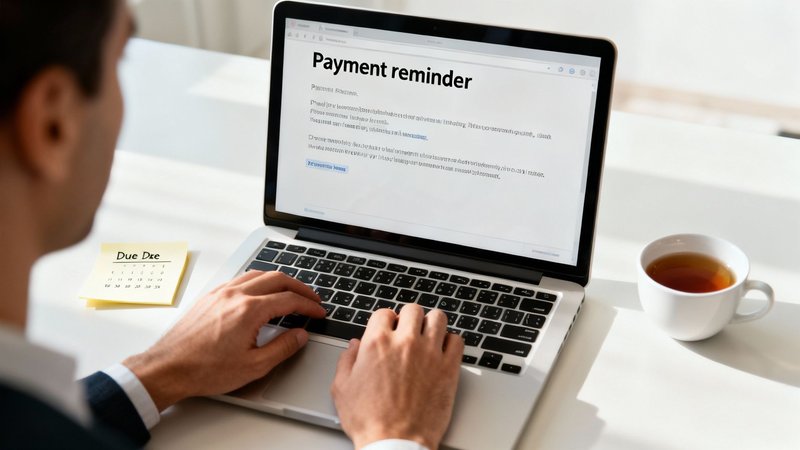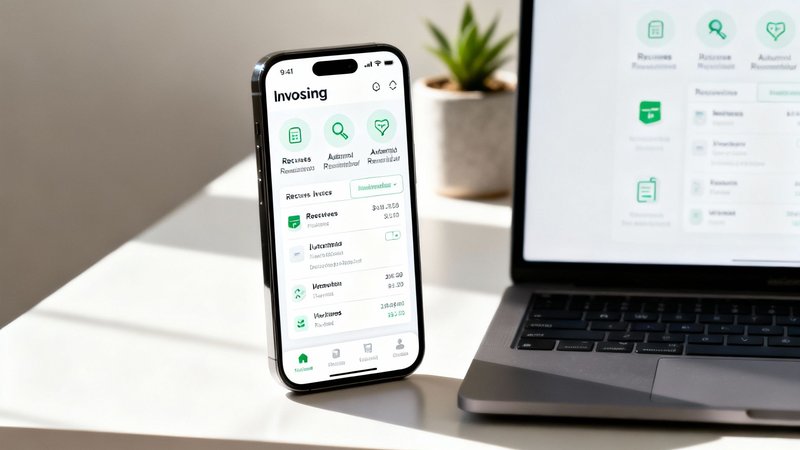
What Is Digital Marketing Consulting?
What is digital marketing consulting and how does it work? We explain what a consultant does, why you need one, and how to hire the right partner in Australia.
19 Nov 2025
Struggling with invoicing for freelancers? Our guide helps you create compliant invoices, chase payments, and manage your finances like a pro in Australia.
Blog
Getting paid. It’s the final, crucial step that turns all your hard work into actual money in the bank. Proper invoicing is how you make that happen... by creating a professional, clear, and legally compliant document that spells out exactly what you did, how much you’re owed, and when you expect to be paid.
A great invoice makes it easy for your client to pay you. Simple as that.
Invoicing is the admin chore nobody gets excited about (but it's great getting paid!). You’ve poured your heart and soul into the project, you’ve nailed the delivery, and now… you’re staring at a spreadsheet.
It feels like the boring bit after the creative storm, doesn’t it? But getting this right is the difference between a thriving freelance business and a constant cash flow nightmare.
It's a huge mental shift from being an employee, where money just magically appears in your account every couple of weeks. As a freelancer, you're a business owner. A CEO, even if it's just a company of one. You have to actively go and get what you've earned.
A great invoice isn't just a demand for payment; it's a professional handshake. It's your final piece of communication on a project and your ticket to getting paid on time, every time.
Think of it this way: a sloppy, confusing invoice tells your client you're disorganised. Like showing up to a meeting with coffee spilled down your shirt. A clean, professional one says you're a serious operator who values their time... and your own.
Getting this process right involves more than just plugging numbers into a template. It touches on several key parts of running your freelance gig smoothly:
The admin side of freelancing is often overlooked, but mastering it is fundamental to your success. A solid invoicing system is one of the foundational pillars that supports everything else you do.
We'll unpack all the common fears... like looking too pushy when you set payment terms, or getting the ATO details wrong and having a minor panic attack. For a deeper dive, check out our guide on the admin you need to nail as a freelance marketing consultant for more tips on staying organised.
The goal here is simple: we want to give you the confidence to hit 'send' on every single invoice without a second thought.

Alright, let's get into the nitty-gritty. This is where we build an invoice that actually works in Australia. Forget those generic templates you find online for a moment... most of them are missing the crucial details that the Australian Taxation Office (ATO) genuinely cares about.
Think of your invoice as the final, critical step in getting paid. If you mess up this part, the whole process grinds to a halt. In Australia, the ATO has a specific set of rules you need to follow, especially once you're in the GST system.
But this isn't just about keeping the tax man happy. A professional, compliant invoice makes you look like you’ve been in the game for years, even if you’re just starting. It gives your clients confidence and makes it dead simple for their accounts team to pay you. No questions, no delays.
To kick things off, let's cover the absolute must-haves. These are the elements that can get you into hot water if they're missing, particularly if your business is registered for GST. The first step to creating a compliant invoice is understanding what defines a tax invoice in the eyes of the ATO.
Here’s a quick rundown of the essential components every Australian freelancer needs on their invoice. Getting these right is the foundation of a professional and, most importantly, payable invoice.
With a freelance sector that includes over 4 million Australians, nailing these fundamentals is more important than ever.
And here’s a critical point: if your annual turnover tips over the $75,000 mark, you're legally required to register for GST. This means your invoice officially becomes a 'Tax Invoice' and must explicitly show the GST amount.
Once you’ve got the legal stuff sorted, the next hurdle is clarity. This is where you can prevent those annoying back-and-forth emails from a client who doesn't understand what they're paying for.
The biggest mistake I see freelancers make is using vague service descriptions. A line item that just says ‘Marketing Services’ is a massive red flag for any accounts department. What does that even mean?
You have to break it down. Instead of being vague, get specific:
This small detail does more than just clarify the work. It justifies your fee and reminds the client of the tangible value you delivered, making them feel good about paying you. It turns your invoice from just a bill into a summary of your achievements.
This is a big one. Seriously.
So many freelancers get tripped up here. We're often so ridiculously grateful for the work that we forget to clearly define how and when we actually get paid. The excitement of landing the project completely takes over, and the money part feels... awkward.
Let's fix that. Because setting clear payment terms isn't pushy. It's just good business. You're a professional running a business, not just a person waiting for a paycheque. Getting this right from the start saves you from so many awkward conversations later on.
Okay, so what’s reasonable to ask for? You’ll generally see a few standard options floating around, and each one has its pros and cons for your cash flow.
My advice? Start with 14-day terms. It shows you’re professional but also that you respect your own cash flow needs. If a big client insists on 30-day terms, you can agree, but you need to be aware of the impact on your finances.
Setting expectations from day one is everything. Your payment terms are part of your professional boundary. They signal that you value your work and expect to be compensated for it in a timely manner. It’s not aggressive; it’s assertive.
Now, let's talk about the single most powerful tool for protecting your cash flow. The deposit.
Asking for a portion of the project fee upfront... usually 50%... is a complete game-changer. It does two brilliant things at once. First, it immediately gives you cash to work with, covering any initial expenses and giving you breathing room.
Second, and maybe more importantly, it acts as a fantastic filter. A client who pays a deposit is committed. They're serious about the project and have skin in the game. It weeds out the tyre-kickers and those who might disappear once the work is done.
This simple step can help you turn short gigs into long-term clients because it establishes a relationship based on mutual respect and investment from the beginning.
No one likes being the bad guy, but you also can’t run a business on goodwill alone. A polite but firm clause about late fees is your safety net.
You don't have to be aggressive about it. Just add a simple line to the bottom of your invoice and in your initial agreement. Something like, “Payments are due within 14 days. A late payment fee of 2% may be applied to overdue accounts.”
You might never even have to use it. But just having it there sets a clear expectation that your deadlines are to be respected. It’s about creating a structure that protects you, just in case.

It’s that sinking feeling every freelancer knows. An invoice ticks over from 'due' to 'overdue', and your mind immediately jumps to the worst-case scenario. Did they hate the work? Are they about to ghost you? Is this the beginning of the end?
Let’s take a collective deep breath. In my experience, 99% of the time, a late payment is just an honest mistake. Your perfectly crafted invoice is probably sitting under a pile of paperwork or lost in a labyrinthine accounts payable system you have no idea about. It's almost never personal.
The real trick is figuring out how to follow up without sounding desperate, rude, or aggressive. You want your money, but you absolutely want to keep the client. It’s a delicate dance, but you have to learn the steps.
You did the work. You deserve to be paid.
Your first move shouldn't be a demand for payment. Think of it more as a friendly, helpful reminder. The goal is simply to pop your invoice back to the top of their to-do list without making anyone feel awkward.
A simple email the day after the due date is perfect. Keep the tone light, friendly, and assume the best. You’re essentially acting as if you're just helping them stay organised.
Here’s a simple template you can adapt:
Subject: Just checking in on Invoice #2024-015
Hi [Client Name],
Hope you’re having a great week!
Just wanted to send a quick reminder that Invoice #2024-015 was due yesterday. I've attached another copy for you just in case it got lost in the shuffle.
Please let me know if you have any questions.
Cheers,
[Your Name]
See how simple that is? It’s not accusatory; it’s helpful. Re-attaching the invoice makes their life easier, which is a small but professional touch clients really appreciate.
And don't feel like you're alone in this. Late payments are a massive challenge for Australian freelancers. A global study found that a staggering 85% of freelancers deal with late payments, with a tiny 15% reportedly always getting paid on time. You can read more about how freelancers can manage these payroll challenges on Procloz.com.
Alright, a week has gone by since your gentle nudge and... crickets. No reply, no payment. It’s time to be a little firmer, but still professional. The tone shifts from "just in case you forgot" to "I need to confirm this has been received."
This is where you can be more direct. A quick phone call can often clear things up in minutes if you're comfortable with that. If you stick with email, your next message should still be polite but leave far less room for interpretation.
Here’s how you can follow up about seven days after the due date:
You’re not picking a fight; you’re just managing your business's finances. This systematic approach to invoicing for a freelancer is what separates the pros from the hobbyists. It helps you maintain control over your cash flow while preserving the client relationships you've worked so hard to build.

If you're still painstakingly crafting invoices in a Word document, we need to have a little chat. It’s a bit like using a paper map when you have Google Maps in your pocket. It works… but why would you put yourself through that?
We live in an age of incredible, affordable software that can automate almost this entire process for you. Seriously. Imagine getting hours of your life back every single month. That’s the real power of finding the right tech to handle your freelance invoicing.
The market is flooded with options, from simple free tools to comprehensive accounting platforms like Xero or MYOB. It can be a bit overwhelming, to be honest. The key is to ignore the fancy bells and whistles and focus on the features that will actually save you time and headaches.
Here’s what really matters:
Moving to a dedicated invoicing tool isn't just about efficiency. It’s about professionalising your entire operation. It sends a clear signal to your clients that you are a serious, organised business that’s easy to work with.
When you're just starting out, a simple, free tool might be all you need. But as your freelance business grows, especially if you start working with international clients, your needs will definitely change.
This is becoming more and more common. In fact, approximately 37% of Australian companies now engage freelancers from overseas, which adds a whole new layer of complexity with different currencies and tax rules.
Platforms like Wise Business have become incredibly popular because they let freelancers easily create invoices in multiple currencies and track everything in one place. You can find more details about how to invoice for freelance work across borders on Wise.com.
Ultimately, the best invoicing for freelancer software is the one that fits your current business needs. To help streamline your workflow, consider exploring some essential productivity tools for freelancers that can integrate with your process. And if you're looking for more ways to stay organised, we've got a great list of the top tools for fractional marketers that can help you manage everything from projects to payments.
Still got a few questions buzzing around? You're not alone. I remember when I started, my invoicing process was a chaotic mix of hope and a badly formatted Word doc.
Getting your invoicing system dialled in can feel tricky at first. It often seems like there are a million tiny rules you're just supposed to know. So, let's clear the air and tackle some of the most common things we get asked by Australian freelancers who are just trying to get paid without the fuss.
This is probably the biggest one. The short answer? Not always.
It all boils down to your annual turnover. The magic number set by the Australian Taxation Office (ATO) is $75,000. If your freelance business pulls in that much or more in a financial year, you absolutely must register for GST. No ifs, no buts.
If you're earning less than that, it's completely optional. Some freelancers choose to register anyway because they feel it makes them look more established, but just remember that it means you'll need to start lodging Business Activity Statements (BAS). It definitely adds a layer of admin, so think carefully before you jump in.
Ah, the dreaded invoice number. It feels so official, doesn't it? The most important rule here is simple: consistency. Please, for the love of organised finances, don't just pluck a random number out of thin air each time. Your future self will thank you.
A simple sequential system like 001, 002, 003 is perfectly fine when you're starting out. Easy.
A slightly better method is to include the year, like 2024-001, 2024-002. This little tweak makes it so much easier to find things when you're looking back. Some people even create project codes for clients, like CLIENTA-001, CLIENTB-001.
Honestly, just pick a system that makes sense to you and stick with it.
The goal isn't to create the world's most complex filing system. It's to create a simple, logical trail that you can follow. Don't overthink it, just be consistent.
Yes, you can... but you can't just spring it on a client after the fact. That’s a surefire way to poison a good relationship.
This is something that needs to be agreed upon from the very start. It should be a clause in your service agreement or contract, and you should also repeat it in the payment terms on your actual invoice. It’s all about setting clear expectations upfront.
A simple line will do the trick. Something like: 'Payments are due within 14 days. A late fee of 2% per month may be applied to overdue accounts.'
This sets the boundary clearly and professionally. It gives you the legal right to charge it if you ever need to, and it signals that you take your payment terms seriously.
Feeling more confident about your invoicing is a huge step, but what about finding those high-quality clients in the first place? At Cemoh, we connect Australia's best businesses with the top 1% of marketing talent. Join our curated network to find freelance, fractional, or permanent roles that match your skills and ambition. Find your next opportunity at https://cemoh.com.
Here are some suggested articles that are closely related to this post

What is digital marketing consulting and how does it work? We explain what a consultant does, why you need one, and how to hire the right partner in Australia.

Finally, a practical marketing strategy for small business owners in Australia. No jargon, just real-world advice to help you connect with customers and grow.

Need a marketing consultant for small business? Discover expert tips and guidance to boost your small business marketing success today.

Build a small business marketing strategy that works. This guide offers practical, no-nonsense tips for real results, designed for Australian business owners.

Feeling lost in the Australian job market? This guide has real, practical steps on how to get a job, from fixing your resume to nailing the interview.

Explore how a fractional CMO Australia can elevate your marketing strategy, reduce costs, and drive growth for your business. Find out more now!